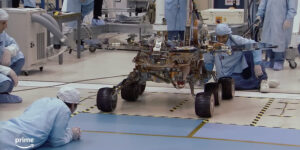Interview with “Good Night Oppy” Director Ryan White
Written by: Christopher Llewellyn Reed | November 23rd, 2022

I reviewed director Ryan White’s newest documentary, Good Night Oppy, out of the 2022 Middleburg Film Festival. It came out in theaters on November 4 and now, today, is available through Amazon Prime. The film tells the tale of the twin Mars rovers Spirit and Opportunity (or “Oppy”), which were meant to last 90 days upon landing on the red planet in 2004, yet made it to 2011 and 2018, respectively. White (Ask Dr. Ruth) chronicles the incredible efforts of the NASA engineers and scientists who made the mission possible, all the while exploring the why of the mission in the first place. Despite focusing on robots, it’s a very human story. Here is a condensed digest of our conversation, edited for length and clarity.

Christopher Llewellyn Reed: Prior to making this movie, did you have a prior interest in space exploration, or was this a new thing for you?
Ryan White: I had a huge interest in space exploration. I was a massive space geek, growing up. I wanted to be an astronaut, as a little kid; it’s a dream that was never realized for me. We had been pitched a lot of space stories over the years and just none of them really checked the boxes that I love about making films. Then this one popped into my life. It was March of 2020, so right at the beginning of COVID. Amblin Entertainment, which is Spielberg’s company, and Pete Berg’s company, FILM 45, brought the idea to me. They had gotten access to NASA and NASA had given them the archive and the blessing to make this film and they were looking for a director and I said yes right away.
CLR: With your partnership with Amblin, that obviously enabled the access to the agencies involved and to a lot of the archival footage. Still, your film features quite a lot of amazing CGI and recreations of the Martian landscape. What was your process in doing those?
RY: I didn’t want to make a film just looking back at Opportunity’s life. I wanted to take the audience on that adventure with her, and the archival was going to give us one way to do that, but I wanted to know if the audience could be taken to Mars through visual effects, and Amblin said, “We don’t know, but our best friends are Industrial Light & Magic, and you should get on the phone with them and see if this is possible.”
I remember those initial conversations and saying to them, “I don’t want to make a cartoon, so if that’s where we’re going to end up, we shouldn’t even go down this path. But I have hundreds of thousands of photographs, each rover has nine cameras on her, so every day of the journey we know exactly what it looks like, and we have the “rover diaries,” which is what Angela Bassett is reading in my film that have all of the data of the day: the level of dust in the air, when the sun rose, when the sun set, the temperature. So, I said, “I have all this data, all this imagery, can you create a photo-realistic, as-authentic-as-it’s-ever-been Mars?” And they said, “We’ve never done that before, but we would love to take a shot at it.”
So, that was the beginning of that process, and it was two years of working with them. I drove them insane as a documentary filmmaker because we were such sticklers for accuracy. I think that, normally, filmmakers go to them and say, “Use your brilliant imaginations,” and I was saying the opposite, like, “Whatever you do, don’t use your imagination. I’m giving you the data.” It was incredibly detailed and hard for them, but they really knocked it out of the park.

CLR: Indeed, they did a great job. So, you mentioned Angela Bassett. Did she come as part of the project when Amblin approached you or did you cast her later?
RW: When Amblin came to me, it was just an idea. Nothing had even been started minus the access to NASA. They came to me, saying, “What’s your vision for the film?” I’m always looking to tell my stories in the present tense, and it sounds like an easier thing, or it sounds like a small thing, but I think it’s actually quite huge in storytelling. So, inevitably when you’re interviewing someone about a robot that has died already, they are going to speak in past tense about it, and so once we found these rover diaries written daily, in the moment, which retained suspense, drama, and emotion, I thought, “What an incredible storytelling device.”
So it was Angela’s voice in my head from the very beginning, but we didn’t go out to her until the very end, until we had locked picture. I thought for sure she would say no, but she said yes. I wanted something maternal, and there’s a tone to her voice that’s very wise, but it’s also very empathetic and maternal, and I wanted that, and so once she recorded and we were able to layer her in, it gave this film the continuity that I’d been looking for.
CLR: Wise and maternal, just like Queen Ramonda in Black Panther. There you go. So, what is that low-ceilinged, tiled space in which you photograph some of your interviewees? I was curious because it repeats.
RW: It’s a warehouse in Los Angeles that has a lighted ceiling that my DP [Director of Photography] could light in different ways, that I just wanted all of my interviews to have, because we couldn’t shoot at Jet Propulsion Laboratories because of COVID, so we had to go to off-campus spots. Infinity was always the idea behind them, since there’s the lighted ceiling, but then there’s the dropoff of black behind them that just kind of fades into infinity. So, we were looking for spaces that had that type of feel.

CLR: You have a lot of copyrighted music in the film and there’s always this argument about fair use, but you have a lot of it because all of the wake-up songs played for the rovers. Did you have to negotiate those rights? Did the Amblin connection make that easy? How did that work?
RW: Fair use is a big thing in docs, but you can almost never “fair use” music. The music industry has figured out a way where that’s a total no-no, somehow. We understood that we should be licensing this music, and I don’t even think we could have made the fair use argument. But, no, I mean, like Angela Bassett, I thought … I had made a Beatles film before, back in 2013. At that time it was virtually unheard of to get Beatles music licensed, and yet we did. It was a movie about The Beatles’ secretary, and they wanted to support her and our little film, and so we got four Beatles songs. But it took me years to get that permission. I knew what that was like.
So this time, I was like, “Oh, God. ‘Here Comes the Sun’ plays such an important role in the movie. I’m pretty sure that’s The Beatles’ number one song on Spotify.” And then I remember talking to our music supervisor, and she was like, “What other songs?” I was listing them out to her, and she went, “Oh, dear God. The second hardest band to license is ABBA; The Beatles and Abba.” So, she tried to manage our expectations, but said she would try. It was one of those things where I was sure they would say no, or that I was sure that the prices would be exorbitant, and we wouldn’t be able to afford them because we did not have a huge music budget.

So, we went to the record labels, and I think there’s just something about this movie and the storyline where you can go to a record label earnestly and say, “Just hear us out, we are a documentary, but we’re not using your song as soundtrack. Your song was used during a moment of grief or joy or to wake up a robot on another planet, and we have it playing in mission control, and it’s a beautiful moment, or it’s a touching moment,” and all of them said, “Yes.” I have seven songs in the film, there wasn’t one record label that rejected us. Those were our top seven choices, and they all were willing to work within the construct of what we had. I think it’s a testament to that adorable little log line of a robot that was supposed to live for 90 days but survived for 15 years. It just does something to people’s hearts where politics and dollar signs and all these things get stripped away just for heart.
CLR: What a great testament to the power of your film. Well, thank you so much, Ryan.
RW: My pleasure.

